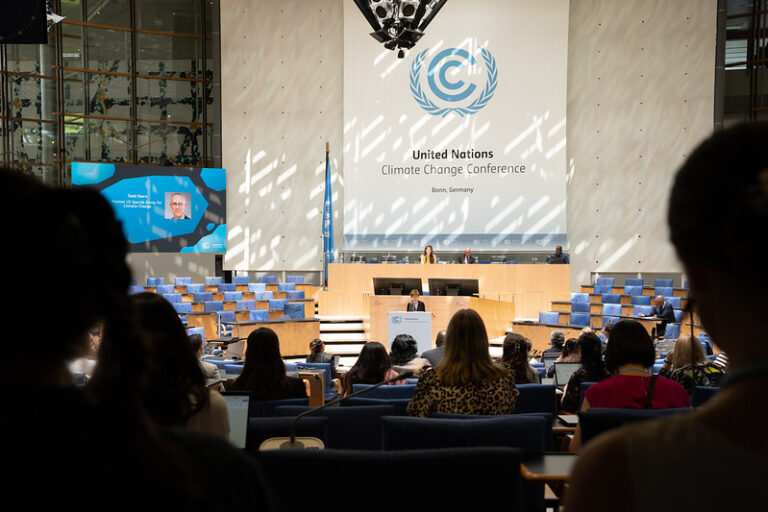Turning promises into progress: why NDCs need clear implementation plans

Countries are lagging behind in submitting their updated nationally determined contributions (NDCs) to the Paris Agreement – and a major discrepancy remains between climate pledges and projected emission reductions. Tiffanie Chan and Carol Yuen review those that have been submitted to provide insights into how countries plan to bridge this implementation gap.
The United Nations Framework Convention on Climate Change (UNFCCC) June Climate Meetings are currently underway in Bonn, Germany. This annual mid-year climate conference brings together the Subsidiary Body for Scientific and Technological Advice (SBSTA) and the Subsidiary Body for Implementation (SBI) to advance international negotiations on key climate issues. Often viewed as the halfway point between the annual ‘COPs’ (summits of the Conference of the Parties to the UNFCCC), this year’s meetings are especially significant. Countries are expected to submit updated NDCs – which outline how they plan to reduce emissions and adapt to climate change impacts – as part of the Paris Agreement’s ratchet mechanism under Article 4(3). Updated NDCs are required every five years and should reflect increased ambition compared with previous commitments, in line with the global goal of limiting warming to 1.5ºC above pre-industrial levels.
Not on track
But the world is not on track. The original deadline for submitting updated NDCs containing targets for 2035 (known as ‘NDCs 3.0’) was 10 February 2025, but only 13 of 195 parties met that deadline. In response, the UNFCCC Secretariat extended the deadline to this September. The extension has been criticised for being a “telling indictment of the blasé attitude towards NDCs to date”, but there is also a prime opportunity to change course and step up ambition in the coming months. As of 25 June 2025, only 24 parties have submitted their updated NDCs.
The 2024 Emissions Gap Report from the UN Environment Programme (UNEP) found that emissions reductions of 42% are needed by 2030 and 57% by 2035 to get on track for 1.5°C. Crucially, the gap is one of implementation as well as ambition. UNEP’s annual ‘gap’ reports repeatedly highlight the implementation gap: the discrepancy between the emissions reductions a country has pledged in its NDC and those projected under its current domestic policies. Countries are still off track to deliver on insufficiently ambitious 2030 NDCs (the previous NDC round).
As the spotlight rightly turns towards implementation, we review a selection of submitted NDCs to provide insights on how countries plan to bridge this gap.
Communicating credible plans for implementation in NDCs
To be effective, NDCs must be more than ambitious and fair: they must also be credible. NDCs should not be treated merely as a reporting obligation. Preparing an NDC is an opportunity for parties to communicate to other parties and to stakeholders that they are serious about achieving their targets, and that they have a coordinated plan for doing so.
NDCs that embody genuine national transition planning, by providing more detail on sectoral pathways, quantified investment needs and supportive policies, are more likely to appear ‘investible’ and attract private finance. Enhancing credibility in NDCs can also generate positive dynamics at the international level, building trust between countries and stimulating a virtuous cycle of increased ambition in future negotiations and successive NDCs.
However, how much detail they include on how domestic policies will meet the international commitments stated in their NDC is largely down to each country. The basic requirements for NDCs include that parties shall provide the ‘Information necessary for Clarity, Transparency and Understanding (ICTU)’ (Article 4(8) of the Paris Agreement). This includes: providing information on the base year; time frames for implementation; scope and coverage; planning processes; assumptions and methodological approaches; how the party considers its NDC is fair and ambitious in light of national circumstances; and how the NDC contributes to the objectives of the UNFCCC. But crucially, the ICTU only asks parties to state “information on the planning processes that the Party undertook to prepare its NDC and, if available, on the Party’s implementation plans” (para 4(a)) (emphasis added) and “specific projects, measures and activities to be implemented to contribute to mitigation co-benefits” (para 4(d)(ii)).
Given the basic ICTU requirements, countries do not necessarily communicate a coordinated plan for achieving their targets. The diversity of approaches is evident from even just a cursory look at the submitted 2035 NDCs. Some explicitly name existing domestic policies, some refer to institutions in charge of developing future plans, and some refer only to the intention to introduce future policies.
Below, we present examples to illustrate the various approaches:
- Canada’s NDC describes how past and current policies contribute towards the 2035 target and what the government will do moving forward. Targets are supported by references to economy-wide climate plans, including the 2030 Emissions Reduction Plan and various laws and policies, including the Sustainable Jobs Act. Future plans include the proposed amendment to the Canada Business Corporation Act to mandate climate-related disclosures.
- Likewise, Brazil’s NDC outlines both past and future institutions and processes, including the Interministerial Committee on Climate Change, which was originally established in 2007, and a new Climate Plan, which will consist of the National Adaptation Strategy, 16 sectoral adaptation plans and seven sectoral mitigation plans.
- Japan’s NDC makes reference to an implementation plan – the Plan for Global Warming Countermeasures. The Japanese Cabinet approved this updated Plan on 18 February 2025 alongside the submission of the NDC on the same day (the previous version of the Plan was decided on 22 October 2021). This document outlines measures to achieve Japan’s 2035 NDC, and contains various targets and estimates classified by specific greenhouse gases and sectors.
- Singapore’s NDC appears to have a heavy focus on decarbonisation measures, including financing for the early retirement of coal-fired power plants globally. However, while the NDC refers to a number of actions, there is no reference to domestic laws and minimal reference to economy-wide or framework policies. For example, the Singapore Green Plan, which is its mitigation framework, is not mentioned.
- Saint Lucia’s NDC is framed as a “call for support”, with this small island developing state – particularly vulnerable to climate change impacts – looking for investment and support in 10 climate priority areas. It focuses its communication on implementation around previously established institutions, including the National Climate Change Committee and the 2024 Climate Change Act. It also briefly outlines framework policies in adaptation and mitigation, opting for a sectoral approach, e.g. National Adaptation Plan, National Energy Transition Strategy and National Energy Policy.
Finance and capacity
The ability of developing countries to prepare and implement credible NDCs is shaped by access to climate finance. Many NDCs from the Global South are conditional on international support, in line with the principle of common but differentiated responsibilities and respective capacities (Article 2(2) of the Paris Agreement). As in the case of Saint Lucia, countries are encouraged to use NDCs to set out implementation plans detailing investment needs, to mobilise support and facilitate access to finance.
Oversight and accountability for implementation
Communicating implementation plans in NDCs is only the first step. Institutions, processes and policies need to be established at the domestic level to deliver promised actions. In response to the lack of progress, more and more independent tools have emerged to increase oversight, transparency and accountability for countries’ political promises. For example:
- Climate Action Tracker tracks the ambition of NDCs and government action against the Paris Agreement goals.
- NDC Align, a new tool based on the Climate Change Laws of the World database, is designed to assess where NDC commitments have been integrated into domestic laws and policies, and whether key climate governance institutions have been established in practice. NDC Align is currently available for Brazil.
While NDC submission timelines may not perfectly coincide with the introduction of domestic laws and policies, beyond setting ambitious targets that meet their fair share, prior to doing so countries have the responsibility to also assess whether and how these targets will be achieved. A credible NDC commitment should then clearly communicate how current or future domestic laws and policies will meet this ambition.

